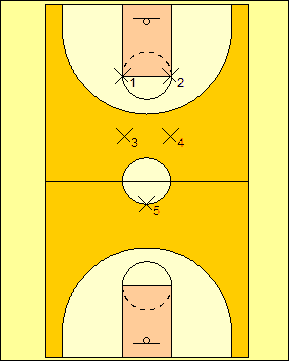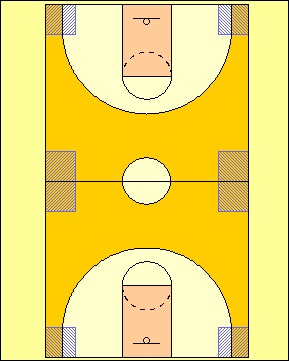|

Basketball Coaching DVD's at Championship Productions
2-2-1 FULL COURT PRESSURE DEFENSE
Maybe you are a coach who wants to speed up the tempo of the game to give your
team a better chance of competing. Or, you could be a coach who needs to
find a way to come from behind to win games late. Either way, if you are
one of these coaches, you probably should consider using a 2-2-1 full court
pressure defense to speed up the tempo, get turnovers, utilize the speed of your
team on defense and get your players to play harder than they already are.
Advantages of the 2-2-1 Full Court Pressure Defense
When considering a full-court pressure defense, there are several items to take
into consideration. There are many significant advantages of utilizing the
2-2-1 full court pressure defense.
-
The 2-2-1 full court pressure defense allows you
to speed up the tempo of the game. For the remainder of
this article, you will need to remember that this is possible
because of the nature of the defense. This defense is put
together for the sole purpose of getting the game to be played at a
quicker pace.
-
The 2-2-1 full court pressure defense is
exceptional at forcing turnovers. The 2-2-1 full court
press does an outstanding job of increasing the pressure on an
offense to get the ball across half court and to score against the
press. If this is not done quickly, it can lead to turnovers
and violations that give the ball back to the defense.
-
The 2-2-1 full court pressure defense requires
your players to play harder. If you have a team that needs
to be motivated to play harder, then the 2-2-1 full court press
accomplishes just that. The press is designed to force players
to play harder on defense and your players must be capable of
responding to the demands for hustle the defense presents them.
-
If you are behind late in games, the 2-2-1 full
court pressure defense can help you come from behind late in games.
Because the defense can cause turnovers, especially those in the
backcourt, the 2-2-1 full court press can get your team started on
double-digit runs when the defense is executed correctly. The
amazement of how quickly you can score to get back into games will
impress your team and your fans.
-
Finally, the 2-2-1 full court pressure defense
can wear out your opponents. Fatigue is a significant
factor in winning games late. No player wants to walk off the
court completely drained of energy. When players reach their
own physical breaking points, they have two decisions to make: play
on and run out of gas or stop playing hard and allow the other team
to come from behind.
Disadvantages of the 2-2-1 Full Court Pressure Defense
However, there are disadvantages of running any kind of full-court pressure
defense. These also have to be taken into consideration and they include
the following:
-
How fast is too fast? If your players
are not capable of playing at a faster pace, then you probably
should consider not running the 2-2-1 full court pressure defense.
The defense is geared towards speeding up the game so you should run
it with the full knowledge that the tempo of the game is going to be
increased.
-
While full court pressure defense can
do a great job in forcing turnovers, the defense is also prone to
giving up easy baskets if the press is broken. If your
teams are playing just for turnovers, you run the risk of giving up
high-percentage shots on the back end of the press. Unless you
have a plan to match point for point, you need to consider
transitioning out of the press as soon as you realize you cannot
force a turnover.
-
How many players are you willing to play and for
how long? If you are not willing to play anywhere from
8-11 players in a game, you may not want to press. Also, if
fatigue becomes a factor, you run the risk of limiting the minutes
of your best players because they will need to rest. These
items have to be taken into consideration as well.
-
If you press late with a lead, that lead could no
longer be considered safe. You have to know when to apply
the press and when to stop pressing. If you lead late, you
will need to consider shortening the game and running out the clock.
Because full-court pressure defense does not slow down the game,
coaches need to know when to stop pressing.
Goals of Any Pressure Defense
The first goal of any pressure defense is to speed up the tempo of the game.
We want our opponents to play at a speed with which they are uncomfortable.
When teams get sped up, it is amazing to see how many more mistakes they make.
Think of it this way: when you are made to do something faster than you want to
do it (mowing the lawn, for example), you make more mistakes than you would
going at a comfortable speed. That is what we want to do when we press.
Second, we want to force turnovers, especially in the backcourt. Turnovers
allow us to transition from defense to offense. We prefer to get turnovers
by having the offense throw us the ball. However, we will also take balls
thrown out of bounds just the same. Either way, we have the ball and an
opportunity to score.
Third, we want our players to play harder. The highest compliment that can
be paid to any coach is how hard your teams play. Eventually teams that
play hard will be rewarded with some form of luck. When that happens, your
team will have the confidence in playing hard and your players will work even
harder on the basketball court to ensure that your team wins more games.
Also, if you have an athletic director, school president, superintendent,
principal or any other administrator who sees that your team is playing hard,
you are more likely to have a job next season regardless of your team's record.
Finally, fan appreciate hustle and dedication, especially if it comes from
playing an up-tempo style of basketball.
Fourth, we want to have the ability to come from behind late in games. It
is a given that teams will trail on the scoreboard at some point in the game.
How you plan for a contingency to come from behind and win is entirely up to
you. No coach ever wants to have the fear of falling behind a certain
amount of points early in a game and not be capable of winning by coming from
behind. If you are going to fall behind, you need to have a press defense
at your disposal so that you can overcome deficits, early and late.
Finally, the last goal of pressure defense is to induce fatigue in our
opponents. When I was at William Jewell College, our team motto was
"Compete at a level your opponent is unwilling to match." If you have your
opponents tired and you are still somewhat fresh late in games, you are
extremely close to getting your opponent to not be able to match your level of
conditioning. Here, one of two things will happen: they will either play
it out and be exhausted by the end of the game or they will stop playing to save
themselves from further physical exertion. If you are able to get the
latter, you will win the game. However, if you get the former, they will
never forget how hard it was to play against you.
Setting Up the Defense
X1 and X2 are the first line of defense and they will start out at the elbows.
What we want from X1 and X2 is to force the basketball to the sideline if at all
possible. X1 will look to trap the ball if it goes to the left and X2 will
look to trap if the ball goes to the right. However, if the offense tries
to go down the middle, X1 and X2 must trap the ball.
X3 and X4 comprise the next line of defensive players
and they will be the ones who will look to trap the ball along the
sidelines. If the ball goes to the left of the defense, X1 and X3
will attempt to trap the ball. If the ball goes to the right of
the defense, X2 and X4 will trap the ball. X3 and X4 are also
responsible as interceptors if X1 and X2 have to trap the ball.
The last defender is X5. His responsibility is to
not allow the ball to be thrown over his head. We want him in this
position because he is our best basket defender.

Diagram 1: The 2-2-1 full-court pressure alignment |
Setting Up the Traps
When setting a trap, there are certain aspects of fundamentals that have to be
taken into consideration. First, the trap must be set by no more than two
players. The rule of thumb to remember is that when you have an extra
defensive player guarding a given offensive player, another offensive player is
left unguarded.
Second, the defensive players need to use their feet and hands properly.
The feet should form a "T" so as to prevent the offensive player from stepping
through the trap. The hands should never reach for the basketball.
The officials are very tempted to call fouls when a player is trapped and
players are reaching for the basketball, even if the takeaway is clean.
Finally, the defensive players should also know the optimal areas for trapping.
The shaded areas in Diagram 2 show the areas where we want to trap with the
defense. Whenever we want to trap, we want to trap in the frontcourt in
the long corners and where the sideline and half court line meet. We will
trap in the backcourt where the sideline and the half court line meet and in the
corners where the sidelines and the baseline meet.

Diagram 2 |
In setting our traps, we have three types of players who are involved in the
process of getting the turnover. We have already discussed the trappers
and what they must do. There are two other groups of players that are
instrumental in successfully forcing turnovers and a faster pace with traps.
Read the full article and many others by signing up for a Coach Peel
Basketball membership today.
Membership Subscription with Monthly Payments: $6.00 per
month
Membership Subscription with Quarterly Payments:
$15.00 per quarter (save over 16.6%)
Membership Subscription with Annual Payments: $50.00 per
year (save over 30.5% & get your first 30 days free!)

© 2010-2017 Alan Peel Enterprises
|